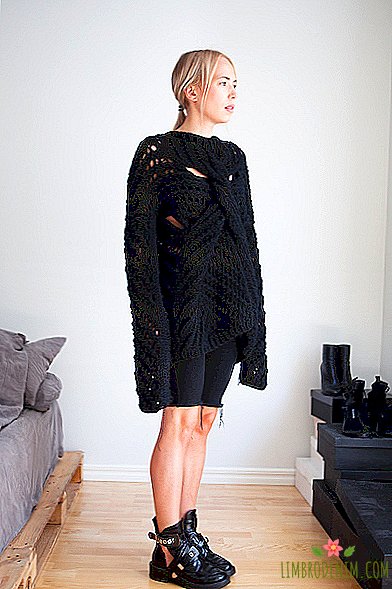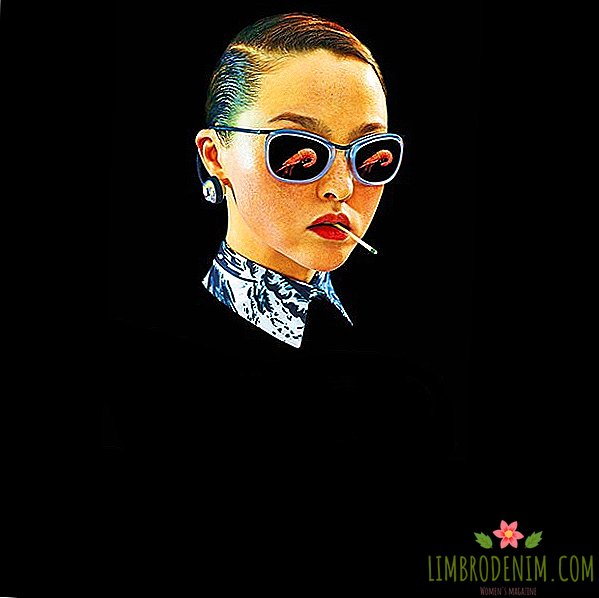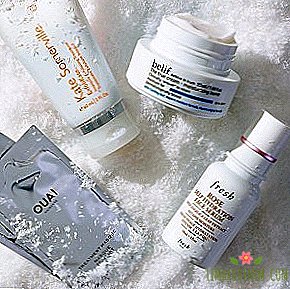Expensive-rich: 10 fashion brands that shaped tastes in Russia
The appearance of "new luxury" - status things that are not screaming about their high prices - made us remember how the image of the glossy and luxurious life in Russia was formed. A conversation about this inevitably starts from the nineties — an era when, due to well-known historical circumstances, the specific tastes of purchasers and the flow of easy money, expensive Western brands and fashion houses selectively came to Russia.
If you multiply this by the fact that the fashion of the 90s as a whole was peculiar, it is understandable why it is customary to talk about those times simultaneously with delight, tenderness and shudder. Two camps reigned in Russia: representatives of the so-called intellectual fashion in the face of Japanese and Belgian designers and designers who promoted artsy femininity with the help of luxurious fabrics, rich decor and sexually emphasized styles. We recall the ten brands that shaped the tastes of Russians and their ideas about high-class clothing, and tell what is happening to them now.


Gianni Versace - the king of the era. He sewed the most fashionable things, was friends with pop stars and promoted a hedonistic attitude towards life, which coincided with the spirit of the times. And of course, the rich Russian women and their life mates liked the silk and gold of Versace who dreamed of luxury and glamor (unlike, for example, the minimalist things of another symbol of the nineties - Calvin Klein). Moscow address "Kuznetsky Most, 19" knew everyone who could afford Italian luxury. This street was the Mecca for the wealthiest shoppers of the capital. This store closed recently - in 2014, the boutique moved to Stoleshnikov Lane.
Versace has long been under the patronage of sister Gianni, Donatella, but continue to exploit their DNA: shiny dresses, mini-skirts with cuts, gold chokers, jack-up boots, silk shirts with Medusa's heads are found in almost every collection of the brand. Surprisingly, the brand now seems to be re-integrated into the modern context as opposed to the course on "new comfort". It is logical that the clientele of the brand in the world and in Moscow began to gradually become younger, so strategically both the Italian and the Russian brand teams are doing everything correctly and on time.


For the so-called buyers of the last century, expensive men's suits were a real gift from heaven. Due to too high taxes and customs duties, the founders of Moscow retail carried on a gray business - in the declarations for which Italian products were imported, the cost of the costume did not exceed $ 50, and then sold them about twice as expensive as in Europe (on average for 2000-4000 dollars). Entrepreneurial businessmen managed to persuade some fashion houses for this trade in Russian, with recalcitrant people working through semi-legal offshores. Thus, in Moscow retail of the nineties, profitability was like that of oil companies. And the more expensive the item was, the more profitable it was to buy it.
Founded by the great Nino Cherruti, a teacher of Giorgio Armani, the Cerruti brand (and her second line Cerruti 1881) in the nineties quite successfully competed with Brioni costumes and, in fact, Giorgio Armani. The expensive costumes that are popular in Moscow were bought by the networks of "elite boutiques", the names of which you most likely remember - these are the Three Fat Men shops, which were reborn in the middle of the zero in the Grand Person network. The chain had a great legend in its arrogance, according to which the retailer was the direct heir of the French pre-revolutionary salon in St. Petersburg. But it all worked out: at Cerruti 1881, many bought the very same crimson jackets, and to this day the costumes of the Italian brand are stored in the wardrobe of those who lived well in the nineties.
According to the official website of the brand, there is still no official Cerruti store in Moscow, but it is in Pyatigorsk. And the brand itself is now not as popular and universally known as in the last century, the women's line was closed in 2011, but in general, nothing has changed for loyal fans - traditional expensive costumes of the brand's master are sewn as they were sewn.


Rei Kawakubo with her brand has become one of the main "Japanese" who excited Paris in the eighties-nineties. Just then, COMME des GARÇONS began to rapidly grow in popularity, proving by its own example that the unusual aesthetics and conceptualism of the brand is not a hindrance for large sales. True, popularity in the world did not at all guarantee success in a specific post-perestroika Moscow, but everything turned out: Rodion Mamontov, the co-founder of the first Russian concept store Leform, which launched a new fashion wave for Russia, brought an unusual brand to the capital Moscow.
In the nineties, COMME des GARÇONS were sold only there, on Povarskaya - people looked on with suspicion, but bought it. At the same time, “on the mainland,” the brand rapidly turned into a conglomerate, producing the second, third, and tenth lines, releasing perfumes and accessories. The Kavakubo universe looped when in 2004 the designer opened the Dover Street Market department store in London, selling items of both her own brands and the brands she patronizes (under the tute of COMME des GARÇONS, for example, Gosha Rubchinsky).
It turned out a story for everyone at once: thanks to the variety of lines, for example, gym shoes from the COMME des GARÇONS x Converse collaboration or a student can buy a t-shirt with a recognizable heart from the Play line. The retailers buy the first lines of the brand carefully: there are still not so many connoisseurs in Moscow and the world, and the cost of this clothing is serious. Having built her business competently, Kawakubo gave herself free rein, and now her prêt-à-porter collections look like anime artists ’fantasies come to life, which is still cool, but it’s rather indirectly related to the commercial part of fashion: collectors and museums buy things. .


Remember the signs "Clothing and Shoes from Italy"? Vicini became literally synonymous with the phrase "Italian shoes", which then meant that you can believe the brand. The brand, which was launched in the mid-nineties, was one of the first to enter the dangerous but generous Russian market - and hit the hook: the well-known combo "Vicini, Fabi, Baldinini" ranked with Christian Dior, Prada, Yves Saint Laurent and other big brands. The difference in pricing policy was compensated by the lack of diversity in Moscow, so Vicini boutique harmoniously fit into the galaxy of expensive shoe stores on Tverskaya and was associated with fashion in the most original sense of the word - the first secular girls of the capital wore Vicini shoes.
When everything was a little settled, the fashionable veil gradually flew off, and now the fashion brand Giuseppe Zanotti owned by Vicini is more in charge of the fashion industry, and the Vicini team began to produce models more calmly. Footwear brand, however, is constantly expanding its range - it can be bought in numerous stores No One. From the category of trendy brands, Vicini has moved into the category of "just shoes" - however, quite expensive (in the region of 25-40 thousand rubles, taking into account the current rate).
The reborn brand looks quite decent, with the design there is everything in order, but the clientele is predominantly adult and not the most fashionable. Perhaps this is due to the fact that the market now offers a huge number of more current brands with similar pricing policies. But in the Russian regions, where far from all the brands represented in the capital have reached, Vicini shoes are still very popular, and the demand for it has not yet fallen.


About how Helmut Lang changed the fashion of the nineties, you can read in detail in the September text of Sarah Mauer on the Vogue website. He was the first of talented Belgians who, at the end of the twentieth century, dressed the progressive fashionable audience into concise, simple and complex (in all respects) things. Helmut's collections still look relevant, and the innovations he introduced have taken root - for example, in 1998 he was the first to stage an online broadcast of the show. The new minimalism, the new sexuality, which came to the liking of both supermodels and the generation of young Western intellectuals, all this became a weighty argument for the first Russian buyers.
But you need to understand that at first the unfamiliar and not sufficiently well-dressed, by the capital standards of those times, had exactly the same audience as Dolce & Gabbana and Roberto Cavalli. For them it was an experiment, and he, undoubtedly, was a success and turned into a good habit. At the same time, the fate of the brand, unfortunately, was unfortunate: in 2005, Helmut sold the Prada Group brand and left the fashion industry, and his place was taken by the design duo of Michael and Nicole Kolovos. In 2014, they left as well, although they managed very cleverly to write the Helmut Lang codes into new realities. The story of the brand is over, and the collection autumn-winter 2014 has become its last. We hope that only for the moment.


Tretyakovsky Passage, which has almost become a household name, is a good example of the fact that the sense of time of the Mercury group of companies is ok. Dolce & Gabbana recently rebuilt, opened the first monobrand Céline in Russia, and only Roberto Cavalli remains the unshakable pillar of luxury sprinkled with gold and sables. The point here, of course, is not Mercury’s special attitude towards the brand, but the brand’s politics itself - the stylistic vector of Roberto Cavalli, as before, incorporates a leopard print, crystals, furs and stilettos.
With the arrival of the creative director of the house of Peter Dundas on the post, hardly anything will change, so we can only make sure that some Moscow girls are still not averse to dress in the "luxury" from head to toe. The first store of the brand appeared in Moscow in 2004, where it still works. For the above reasons, it is there that they go for pointedly elegant evening gowns, high-heeled shoes up to the skies and fur coats embroidered with stones. And this once again proves that the concepts of luxury formed in the nineties are still alive in Russia. Only in the nineties it was fashionable, and now it is moving more confidently towards secular subcultures.


Yoji Yamamoto was the second sensational discovery of the eighties and nineties, making up with the Ray Kawakubo the core of the Paris-Japanese wave. In his black robes, jackets, similar to the pinned pieces of fabric, and dresses of complex cut on thin straps, bohemians and creative intelligentsia were wearing, and after them some Hollywood actresses from the A-list. In Moscow, Japanese deconstructivist things were initially sold in the landmark for the capital James and in the Central Department Store. In 2000, a flagship was opened in Stoleshnikov Lane, which, however, existed for only a short time - there were not as many true fans of the brand as expected.
It turned out that the pool of fans for Helmut Lang, COMME des GARÇONS, Yohji Yamamoto and Maison Margiela with Dries Van Noten in Moscow is about the same. This is not the most numerous stratum of people who do not want the price to be supported by a well-known logo, but recognition is important to them to a certain extent. The second line of the brand - Y-3 - is growing and developing, the same can be said about the main Yohji Yamamoto, which, contrary to the bankruptcy declared in 2009, exists quite well and, according to Yamamoto, actively attracts the young public. And yes, now the Japanese designer is 72 years old, full of strength and health, and his clothes are already worn by all - both old-fashioned artists and simply rich students who prefer everything else to comfort.


Dries Van Nothen was one of the famous "Antwerp Six" - a pool of designers, graduates of the Royal Academy of Fine Arts in Antwerp, who in the late 80s and early 90s became the founders of the avant-garde Belgian wave in fashion. But of the six, only Dries managed to preserve and develop his eponymous brand in the form in which it was originally conceived. Dries Van Noten still does not belong to any conglomerate, does not produce cosmetics, does not make the main cashier for the sale of perfumery, but puts it on clothes that are sold in a limited number of stores - and it feels good.
In the nineties, the purchase of conceptual designers due to the taste preferences of Muscovites was a risky business, but Dries Van Noten is perhaps the most obvious compromise. The clothes of the famous Belgian are complex enough to be recognizable among connoisseurs, and at the same time bright enough and near classic, so as not to shock the first customers. The first Dries Van Noten brought exactly Leform, where people who are knowledgeable in the subject still often “follow Dries”. The next was TsUM. There is simply no great sense to carry the brand for other stores, well, every second Moscow wardrobe probably has bright coats and ankle boots on a low stable heel thanks to generous sales. Stylistically, everything that Dries Van Notein does is what is called instant classic. You can look up to date in a dress that you bought twenty years ago, and in velvet trousers from the autumn-winter collection. One can only guess how the designer manages to turn this from season to season.


The opening of the first Moscow boutique of the house in 1997, which still works directly with Russia without intermediaries, was personally supervised by John Galliano. Further, perhaps, you can not continue: the lush aesthetics and the underlined sexuality of the Galliano collections came to the place in the late nineties and in the zero. Remember advertising images with oil sprinkled with tanned half-naked Christian Dior models - and you will understand how successful it was to open a brand's mono-brand store in Moscow just then.
On Avito, you can still find bags with Christian Dior monogram canvas, but the brand itself does not look back - John Galliano was fired, and Raf Simons left, but after three years of work at home, he managed to “give Jil Sander” thoroughly: from women flowers as Christian himself conceived in 1947, the clients of the brand turned into a cyber princess. Laconic forms, innovative materials, latex boots, completely revised classics of the brand, new it bags and the new Dior - the name of the founder gradually disappears from the brand name, only the last name remains. And now by the forces of Raf Christian Dior - this is fashion.


Twenty years ago, MMM, along with some of the brands listed above, became a real outlet for those who were not seduced by sheepskin coats on the floor with sharp-nosed boots. From the very beginning of Maison Margiela in Russia, things were going well, and the brand’s flagship store even operated in St. Petersburg for a while. Surprisingly, for the majority of Russian customers, it still remains a strange and niche product. The indicator here is the Maison Martin Margiela x H & M collection: bright and shiny candy clutches snapped up quickly, but silk asymmetrical dresses hung on rails for an unprecedented few days.
The soul of the brand was, in fact, Martin himself, who for twenty years remained anonymous, did not communicate with the press and did not even show his face. But in 2009, he left his own brand, which was bought by the OTB Group - and such things began to happen to the brand that the founder himself would hardly have allowed. For example, perfumery appeared in the brand’s arsenal, which always speaks of commercialization. Last year, a team reshuffle occurred in the team at home: instead of an anonymous group of designers, John Galliano was appointed to be responsible for the design of Maison Margiela. His aesthetics are exactly on the opposite fashionable pole, which caused both surprise and heated discussions. How fans of “good old MMM” will please John’s work in the long run is unknown. Although cashmere turtlenecks with two brand stitches on the back of the MM6 line have not gone away.
PHOTO: Versace, Cerruti, COMME des GARÇON, Vicini, Helmut Lang, Roberto Cavalli, Yohji Yamamoto, Dries Van Noten, Dior, Maison Margiela





